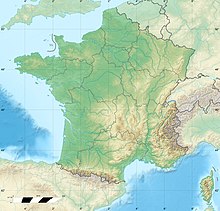Siege of Narbonne (752–759)
| Siege of Narbonne (752–759) | |||||||
|---|---|---|---|---|---|---|---|
| Part of the Frankish conquest in 759. Illustration by Émile Bayard, 1880. | |||||||
| |||||||
| Belligerents | |||||||
|
(752–56) Emirate of Córdoba (756–59) |
Septimanian Visigoths[1][2] | ||||||
| Commanders and leaders | |||||||
|
(752–756) Abd al-Rahman I (756–759) |
Ansemund † | ||||||
| Strength | |||||||
| 7,000 | 29,000 | ||||||
| Casualties and losses | |||||||
| Unknown | Unknown | ||||||
Location in France | |||||||
The siege of Narbonne took place in France between 752 and 759, led by the Frankish king Pepin the Short against the Umayyad stronghold defended by an garrison of Arab and Berber Muslim troops who had invaded Septimania and occupied the Visigothic Kingdom and its Gallo-Roman inhabitants since 719.[1][2] The siege remained as a key battlefield in the context of the Carolingian expedition south to Provence and Septimania starting in 752.[1][2]
The region of Septimania was up to that point in the hands of Andalusi military commanders and the local Visigothic and Gallo-Roman nobility, who had concluded different military and political arrangements to oppose the expanding Frankish realm.[3] Umayyad rule collapsed by 750, and Umayyad territories in Europe were ruled autonomously by Yusuf ibn Abd al-Rahman al-Fihri and his supporters.
Background
The region of
By 721, al-Samh was reinforced and ready to lay siege to Toulouse, a possession that would open up the bordering region of Aquitaine to him on the same terms as Septimania. But his plans were thwarted in the disastrous battle of Toulouse in 721; the Aquitanian Christian army led by Odo the Great, Duke of Aquitaine defeated the Umayyad Muslim army and achieved a decisive and significant victory.[6] The surviving Umayyad forces drove away from Aquitaine with immense losses, in which al-Samh was so seriously wounded that he soon died at Narbonne.[6]
Arab and Berber Muslim forces, soundly based in Narbonne and easily resupplied by sea, struck in the 720s, conquering
Approaches
During the
After capturing
While the Gothic magnates did not support the Franks formerly, things were changing this time: Nîmes, Agde, and Béziers were handed over to him by the Gothic count Ansemund.[10] Mauguio surrendered too. Count Miló was at the time ruling in Narbonne as a vassal of the Andalusians, but when Ansemund handed over several cities to Pepin, Miló did not join, probably deterred by the Arab-Berber Muslim garrison stationed in the city.
Start of the siege

The
Frankish conquest of Narbonne
In 759, Narbonne was not receiving reinforcements from al-Andalus, rife as it was with internal fights.
Aftermath
After the Frankish conquest of Narbonne in 759, the Muslim Arabs and Berbers were defeated by the Christian Franks and expelled to their Andalusian heartland after 40 years of occupation, and the
Notes
- ^ ISBN 9780367184582.
- ^ ISBN 978-1-349-26924-2.
- ^ Meadows, Ian (March–April 1993). "The Arabs in Occitania". Saudi Aramco World. 44: 24–29.
- ISBN 0-7007-1564-9, p. 28.
- ISBN 0-521-29135-6, p. 95.
- ^ JSTOR 48578218..
After three months, Eudo the Great, Duke of Aquitaine, lifted the siege. Eudo's army decimated the Moors, killed As-Sahm and drove the survivors from Aquitaine
- ^ Gallia, again by battles, and had to besiege Avignon and Narbonne there. He did not have the time to conquer Septimania.
- ^ eastern Frankish Mayors of the Palace, or that a sense of Christian solidarity should mean more than the dictates of realpolitik. For that matter it was not with any sense of obligation to free formerly Christian lands from Islamic rule that Charles Martel launched a raid into western Provence in 737. He took Avignon, but clearly did not retain it, and advanced to besiege Narbonne, the centre of Arab control in the March. The Frankish chronicles record his victory over a relieving force sent by the governor ʿUqba, but their uniform silence makes it clear that despite this he failed to take the city itself.
- ^ Meadows, Ian (March–April 1993). "The Arabs in Occitania". Saudi Aramco World. 44: 24–29.
- Lewis, Archibald R. (1965). The Development of Southern French and Catalan Society, 718–1050. Austin: University of Texas Press. Retrieved June 15, 2012.
- ^ Lewis, Archibald R. 1965

